
January 16, 2015
Over the last week, we've taken a look at where the Eagles' 2014 season went wrong in a five-part series. In case you missed any of the ugly chapters, here's a comprehensive post for your convenience.
If you are a football fan, you already know that it's difficult to win football games when you turn the ball over. That's as obvious as football analysis gets. But just to hammer the point home, according to ColdHardFootballFacts.com, from 2008 to 2012, teams who won the turnover battle had a winning percentage of 0.786:

In 2014, the Eagles won the turnover battle in just four games:
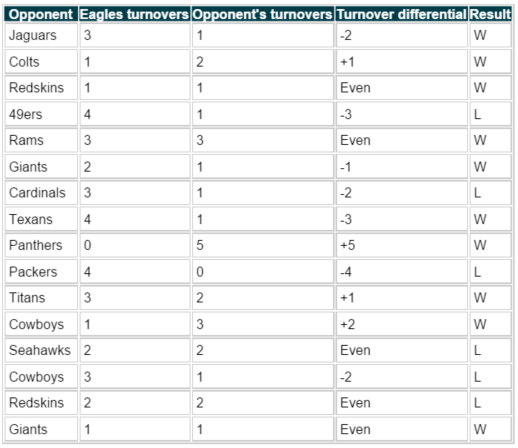
They won all four games they won the turnover battle, were 3-2 when it was even, and 3-4 when they lost it. On the season, they had a total turnover differential of -8. During the 2014 season, there were eight teams that had a turnover differential of -6 or worse, listed here:
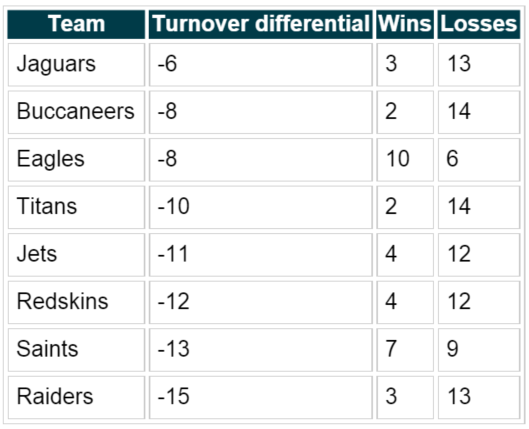
If you'll note, the Eagles are the only team among the teams listed above that had a winning record. In fact, if you were to take the Eagles out of the mix, the other seven teams had a combined win-loss record of 25-87, or a winning percentage of 0.223. In other words, in terms of turnover differential, the Eagles were among the absolute dregs of the NFL.
Even worse, no team turned the ball over as much as the Eagles. The Eagles not only had the most turnovers in the NFL, with 36, but they led the NFL in interceptions thrown and tied for the league lead in fumbles lost. They basically won the "Triple Crown of Terrible Ball Security." (trademarked):

If you're a glutton for punishment, you can watch all 36 turnovers in less than 35 seconds below:
This is nothing new. The Eagles have been a horrible ball security team over the last four years. Since 2011, they have turned the ball over 130 times, or more than twice per game on average. That also leads the NFL over that span:
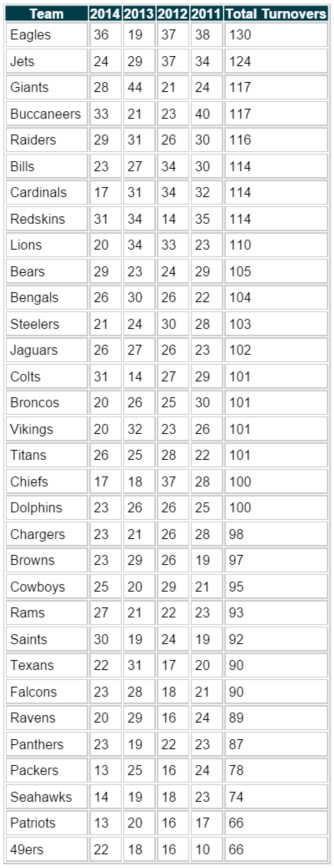
If you'll note above, seven teams over the last four years turned the ball over at least 36 times. The Eagles did it three times:
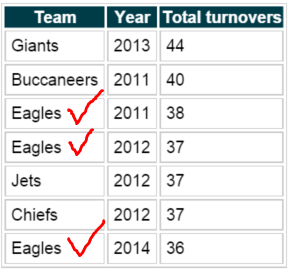
Some view turnovers as luck-driven. In the case of the 2014 Eagles, that was hardly the case. They got poor QB play for the better part of the season, and their skill position players were careless when they ran with the football. It's really kind of incredible that they won 10 games while leading the league in turnovers, but ultimately, their sloppiness (and not just bad luck) on offense was a major contributor to the downfall of the 2014 season.
The 2014 Eagles gave up 72 pass plays of 20+ yards. That was the most in the NFL, with the next closest team being the woeful Chicago Bears, who gave up 65. The Eagles also gave up 18 plays of 40+ yards, which was also the most in the NFL.
To put into context how large that number really is, the below chart shows all the teams since 1991 (when the NFL began tracking 20+ yard plays) that gave up 70 or more 20+ yard pass plays in a season:
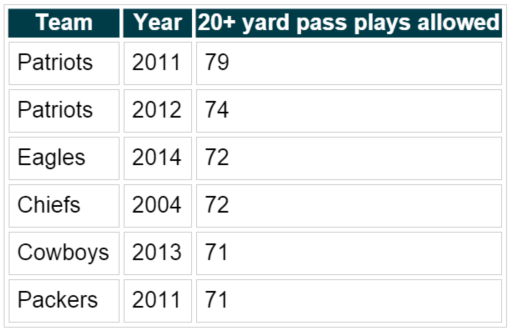
In many ways the Eagles' defense was good in 2014, especially the front seven. But all it really takes is to have one glaring weakness to wreck all the good, as noted by defensive coordinator Billy Davis after the Eagles' loss to the Redskins Week 16.
"The deep pass ball has got to stop," said Davis. "That is what is giving up yards, and our points (allowed) aren't where they need to be. There are a lot of aspects of the defense that have grown. Our run average per attempt is (good), our takeaways are in the top five, our sacks are in the top five, our opponent completion percentage is in the top five. But the one that matters most is points, and that's the one we have to get down, and we're not doing that. That's a product of the deep passing game."
In 2013, the Eagles gave up a number of chunk plays, but opposing receivers rarely got behind the defense completely for long touchdowns. In 2014, it happened repeatedly. The following are all long touchdowns in which an opposing receiver got completely behind the Eagles defense, in chronological order:
Allen Hurns Week 1 for 34:

DeSean Jackson for 81:

Devastating 75 yarder to John Brown:
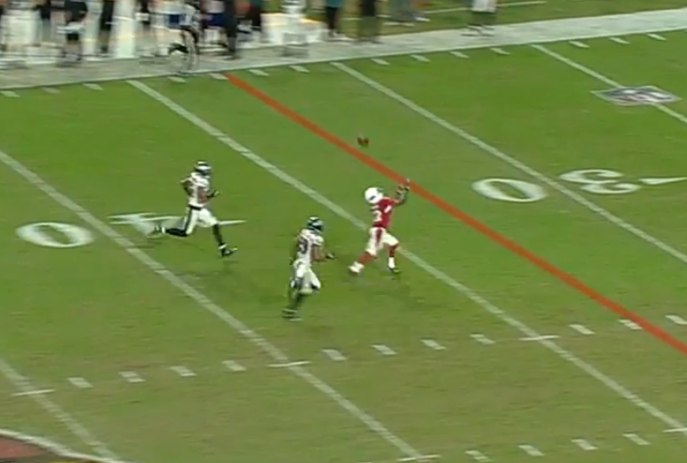
Kelvin Benjamin for 40 (he actually had to come back for this one, but had gotten past the defense):
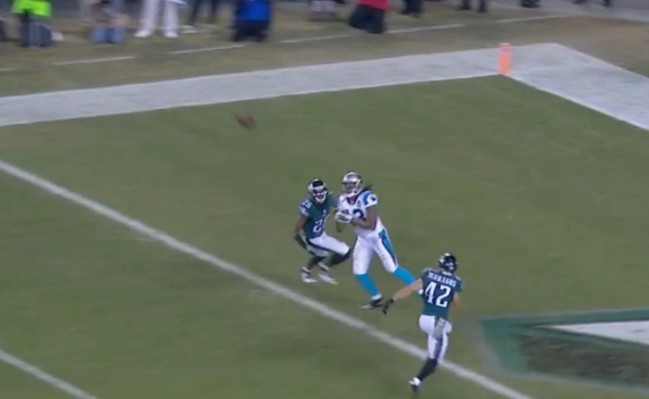
Jordy Nelson for 27:
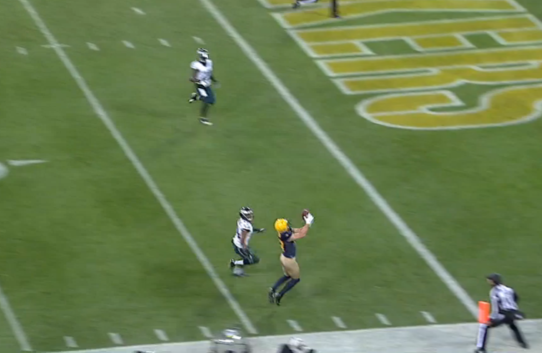
Doug Baldwin for 20:
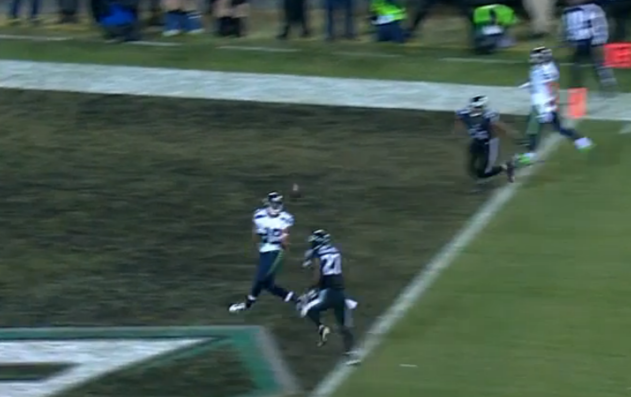
Nate Allen has no anticipation and Dez Bryant beats Bradley Fletcher for 26 yards:
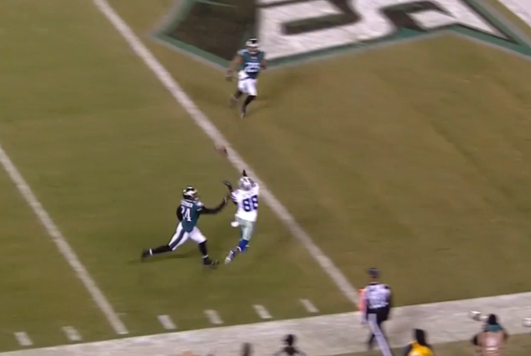
And I promise this isn't the same play as the one above, as Bryant beats them again for 25 yards:
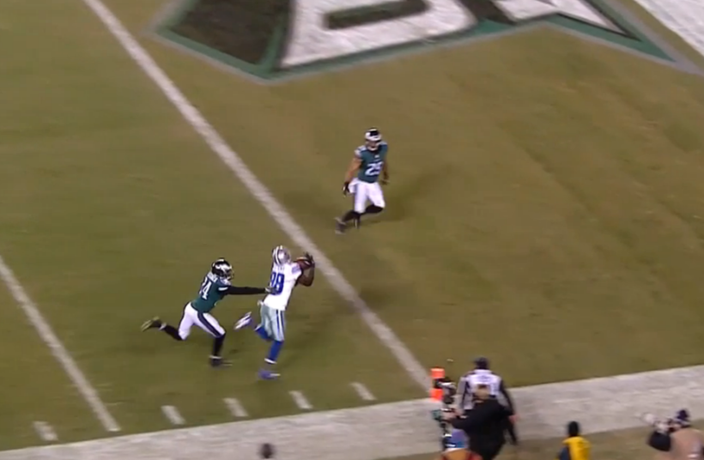
The Eagles have one good starter in their secondary in Malcolm Jenkins, and they have a good slot corner in Brandon Boykin. The other three starting spots were manned by a trio of defensive backs (Cary Williams, Bradley Fletcher, and Nate Allen), who are (generously) below average NFL starters. Until the Eagles get better personnel on the back end, the defense as a whole is going to suffer.
Offensively, the Eagles turned the ball over 36 times, the most in the NFL. Defensively, as noted already, they gave up more big plays than any other team in the NFL. On both sides of the ball, there wasn't a team in the league that had more devastating game-changing plays go against them than the Philadelphia Eagles.
In 2013, the Eagles' offensive line stayed remarkably healthy. Its five starters - Jason Peters, Evan Mathis, Jason Kelce, Todd Herremans, and Lane Johnson - played a combined 98.18% of the offensive snaps. That quintet started all 17 games (including the playoffs), and only Peters played fewer than 99% of the snaps:
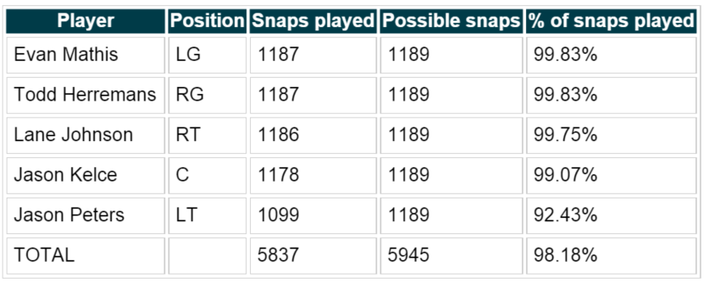
The fact that the Eagles' OL stayed so improbably healthy for an entire season led some analysts to wonder if that was sustainable. If the Eagles didn't have the same kind of luck in 2014, might they struggle to cope with injuries? Those analysts' concerns were valid. In 2014, the Eagles' OL was in a constant state of disarray due to injuries and Lane Johnson's suspension. The 2014 edition of the Eagles starters along the OL played just 68.62% of the team's offensive snaps combined:
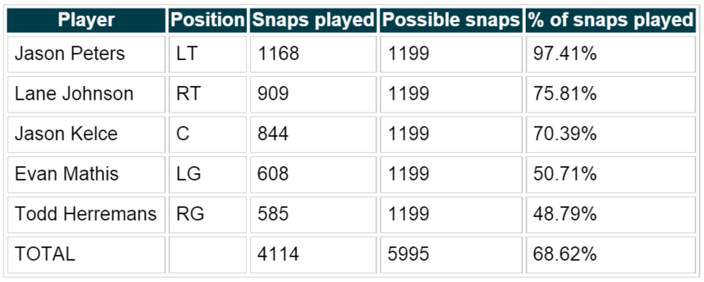
In fact, the starting combo of Peters-Mathis-Kelce-Herremans-Johnson didn't play a single snap together in 2014. A chart of who started each game:
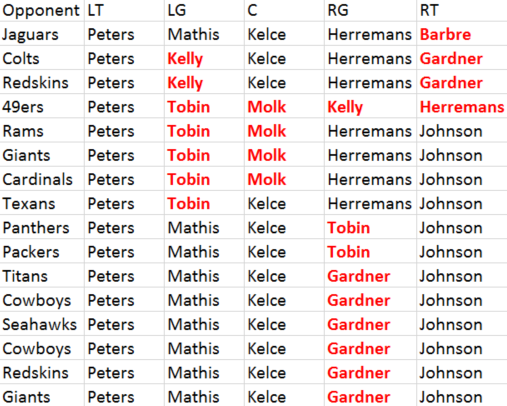
That's a lot of red. Take particular note of the 49ers game, in which four starters were playing something other than their normal position. The Niners' front seven completely dominated the Eagles' OL, and the Eagles rushed for a putrid 22 yards on their way to a 26-21 loss in which the offense didn't score a single point.
Although we already noted that Peters-Mathis-Kelce-Herremans-Johnson started every game together in 2013, let's look at it in chart form, because, well... Charts!

See? No red.
As a result (and among other reasons), the Eagles' offense was nowhere near as potent in 2014 as it was in 2013, especially in the run game:
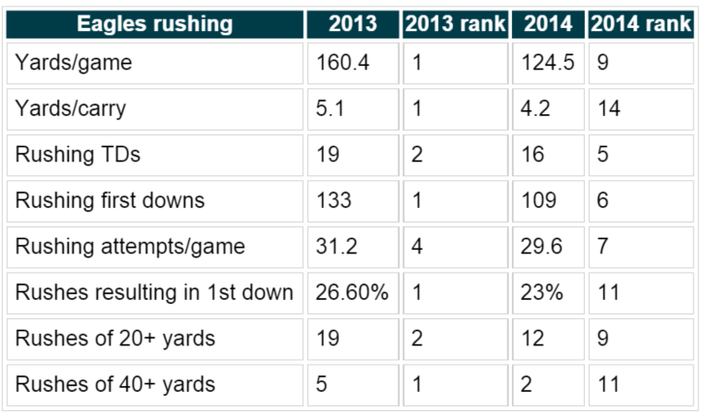
In other words, they went from being the best rushing team in the NFL to one that was merely "good," which in turn had the trickle down effect of affecting the passing game.
In 2013, as we all know, Nick Foles threw 27 touchdown passes and 2 interceptions. During the offseason last year, no reasonable Eagles fan expected Foles to come anywhere close to matching those numbers. However, that didn't necessarily mean that he couldn't improve as a player, even if those numbers would be nearly impossible to match.
But Foles did not get better. Instead, he regressed.
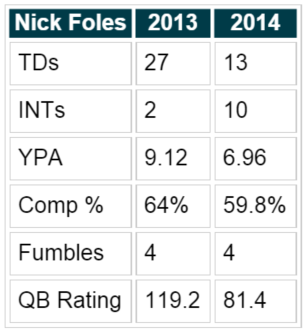
There were certainly a number of reasons why Foles was not set up to succeed the same way he did in 2013, which we'll list here:
No continuity along the OL: In 2013, the Eagles' offensive line stayed remarkably healthy. Its five starters - Jason Peters, Evan Mathis, Jason Kelce, Todd Herremans, and Lane Johnson - played a combined 98.18% of the offensive snaps. In 2014, those five players combined to play in just 68.62% of the team's snaps, and they were never once on the field at the same time. The lack of OL continuity understandably may have led to trust issues for Foles playing behind a makeshift offensive line.
Far less effective running game: In 2013, the Eagles running game was by far the best in the NFL. In 2014, behind the aforementioned banged up OL, it was nowhere near as potent:

When you have the best rushing attack in the NFL, that makes it much easier on the quarterback to be effective. Without the elite run game, Foles did not have the same enormous advantage that he enjoyed in 2013.
Teams around the league adapting to Chip Kelly's fast-paced offense: Chip Kelly's offense, from an X's and O's standpoint, is actually very basic. There was no mystery about what the Eagles offense wanted to do from the opposing defense's perspective. The biggest reason that Kelly's offense is so effective is speed and execution. With so many teams around the league trying to be up-tempo, a theory exists that defenses became more used to preparing for it. If there is validity to that theory, then certainly Foles would have the advantage of teams not knowing how to prepare for the Eagles' offense as well in 2013 as they did in 2014.
New QB coach: 2013 QB coach Bill Lazor left the Eagles to go be the Miami Dolphins' offensive coordinator last offseason. It is nearly impossible to quantify how much Lazor's absence affected Foles' play, but it is something that many fans have pointed out as a difference between the 2013 and 2014 seasons.
While many of the above excuses are valid, aspects of Foles' game clearly fell off. There were several differences in Foles game in 2014 than in 2013:
Deep ball accuracy: In 2013, Foles had tremendous success when he threw the ball more than 20 yards (Stats via ESPN). In 2014, not so much.

Of course, it doesn't help when you lose arguably the best deep threat in the NFL, but Foles' deep throws were often wildly off target. And Foles' inaccuracy wasn't exclusive to deep throws. His overall completion percentage dipped by 4.2%.
Pocket awareness: In the past, pocket awareness was a strength of Foles'. While everyone knows that he's not exactly Usain Bolt, Foles did a good job both in 2012 and 2013 of feeling pressure, sliding away from it and throwing on the run. In 2014, he retreated backward far too often instead of stepping up into the pocket or escaping the pocket laterally. This led both to bad decisions and unnecessary sacks.
Back foot throws: Foles' back foot throws were somewhat of a continuation of his poor pocket awareness. Often, when he would retreat a la Kevin Kolb, he would make inaccurate back foot throws with no juice that rarely connected.
Not seeing open receivers: This was a problem both with Foles and Mark Sanchez. In watching All-22 film after each game, there always seemed to be numerous wide open receiving targets that Foles and Sanchez simply didn't see, or didn't trust. In 2013, Foles seemed to see the field much better.
When Foles was injured in the Eagles' eighth game against the Texans, many fans were almost eager to see what "the other guy" could do, as Foles had not been as effective as expected. Sanchez proved not to be a savior, and in my opinion, was not as effective as Foles. Sanchez was good in games the defense played well and the run game was working, such as the first game against the Cowboys, and the Panthers game. Otherwise, he was prone to turnovers when he asked to make plays, much like his career with the Jets.
While he was certainly nowhere near as good in 2014 as he was in 2013, Foles' injury was more of an impact to the demise of the 2014 Eagles than is typically noted.
In 2013, the Eagles set a new all-time NFL record with 99 plays of 20+ yards. It's a statistic the NFL has been tracking since 1991, and when you think about the number of prolific offenses that have been around since then, what the Eagles accomplished offensively in 2013 seems all the more impressive. The "Run and Shoot" Oilers of the early 90's, the "K-Gun" Bills under Jim Kelly, the Rams' "Greatest Show on Turf," Peyton Manning's teams both in Indianapolis and Denver, the undefeated Patriots, the Randy Moss / Cris Carter Vikings, and the Packers and Saints offenses under Aaron Rodgers and Drew Brees all come to mind.
In 2014, however, the Eagles were less explosive. On the season, the they had 75 plays of 20+ yards, which is still a high number compared to other NFL teams, but not near what they were able to do in Chip Kelly's first year with the team.
Since Kelly's offense came to Philly, the Eagles have scored fast. In 2013, the time of possession on Eagles TD drives, on average, was just 2:08. The next closest team was at 2:32. The 2014 Eagles averaged 2:38 of time of possession per TD drive, which again, is still fast, but not as lightning fast as they were in Kelly's first year.
There's more:
The Eagles' "big play" stats in 2014, without context, seem good. 2:38 per time of possession, 16 drives of less then two minutes, 43 TD drives, 15 plays of 40+ yards -- all good.
The trade-off with Kelly's fast paced offense, however, is that when they don't score, three-and-outs and other short drives happen very fast too. As a result, the Eagles defense had to face more snaps (2263) against them on defense the last two seasons than any other team in the NFL. By comparison, the NFL league average over the last two years is 2065 snaps. The difference of roughly 200 snaps between the Eagles the rest of the league equates to over three games' worth of snaps.
In other words, for that trade-off to work, the Eagles better be explosive, and they weren't "explosive enough." In fact, they were less explosive this season than their opponents:

Last offseason, the Eagles cut a fellow by the name of DeSean Jackson, who was a prolific big play threat. Jackson had more than a quarter of the Eagles' 99 plays of 20+ yards in 2013, with 25. In fact, on drives in which Jackson had a 20+ yard reception, the Eagles eventually scored 17 TDs, seven FGs, and missed two FG attempts, for a total of 141 points. The Eagles scored 30.3% of their total points last season on drives in which Jackson made an explosive play.
In 2014, Jackson led the NFL with 13 receptions of 40+ yards, the same number as the Eagles' entire team.
There are certainly other reasons the Eagles' offense struggled in 2014, like bad QB play and a banged up OL. Still, while the not-so-quantifiable merit of getting DeSean Jackson out of the locker room may have improved the team's #culture, they sure as hell missed his big play ability on the field.
Follow Jimmy on Twitter: @JimmyKempski